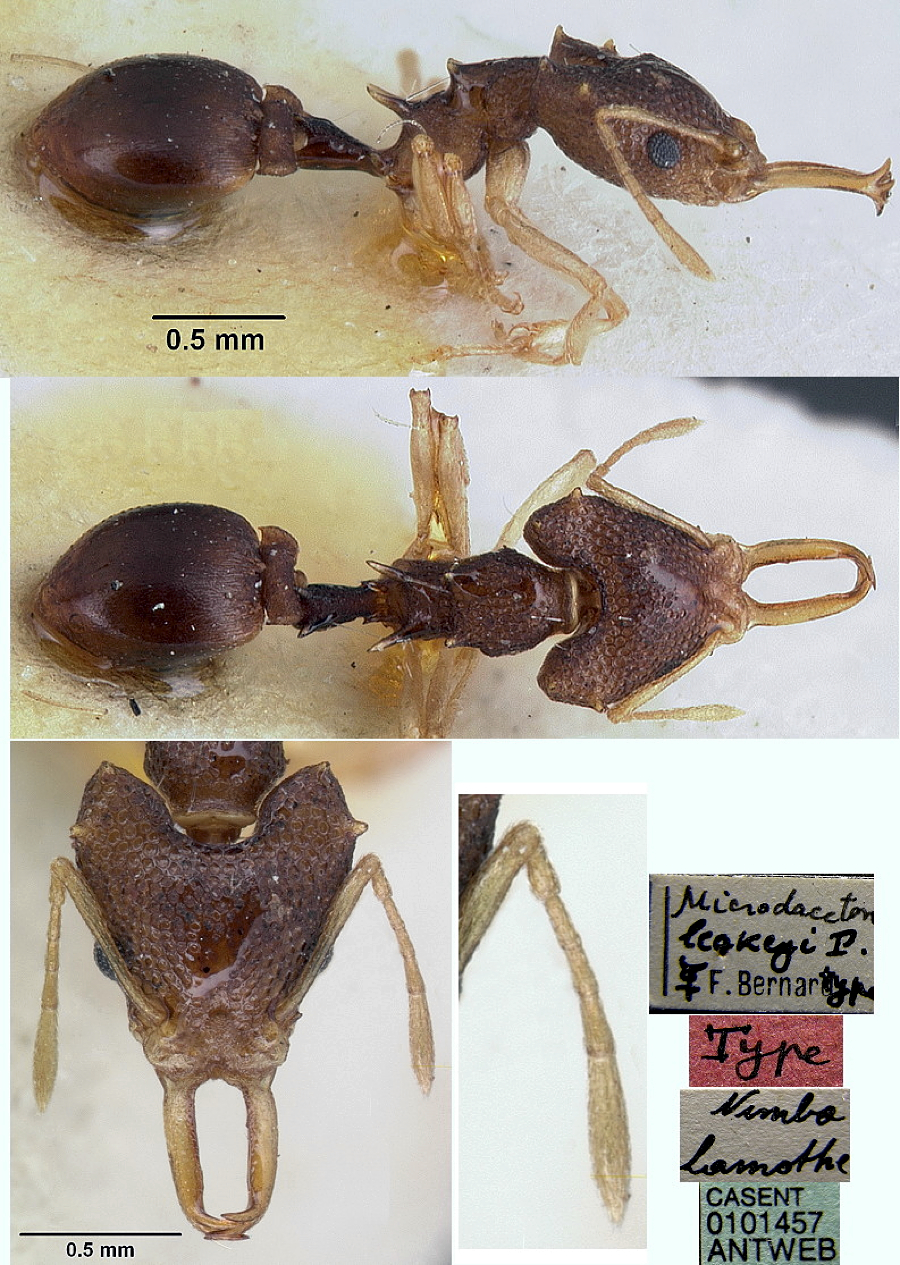 Bernard's description of the workers of "Microdaceton
leakeyi Patrizi" (translation). Bernard's description of the workers of "Microdaceton
leakeyi Patrizi" (translation).
Worker (previously undescribed). Types: 2 workers from the
savanna at Kéoulenta and one labelled "Nimba, Lamotte". The three are
identical and are 2.8 mm long without mandibles, 3.25 with.
Here briefly are the principal characters:
Colour brown, petiole and gaster darker (the queen from Kenya [of leakeyi
as described by Patrizi in 1947] is dark brown, gaster black, length
4.5 mm), postpetiole clear brown, mandibles yellow-red, clypeus and
tarsi clear yellow.
Sculpture very similar to that of exornatum and leakeyi,
save for the gaster: that is finely striated longitudinally on the
basal quarter, the rest shiny, microscopically puncturated (exornatum
is not striated, leakeyi for sure on the basal part, but that
is a queen). The large spines, 12 in all, characteristic of the genus,
are positioned as with the leakeyi queen (those at the base of
the antennae are very short, those on the vertex very close to the
posterior angles, the odd posterior spine on the petiole is reduced to
a tooth, longer with exornatum. Santschi and Patrizi do not
indicate if there is a fine pubescence, without raised hairs. On the
other hand, the example marked "Nimba" shows several raised
macrochetae, short, truncated, whitish (2 on the head, 4 on the thorax,
4 on the gaster): these hairs have disappeared on the abraded specimens
from Kéoulenta.
The author's figures are insufficient for the antennae and the clypeus,
such that a comparison is difficult. Here, the clypeus is elongated,
incurved towards its centre (see fig.); it seems triangular with leakeyi
and oval, not incurved, with exornatum(?). The basal four
segments of the funiculus are not equisized, as it appears from the
figures, but clearly inequal; the 1st is shorter and more globular than
the second, which is equal to the 4th, both being 50% longer than the
3rd. The mandibles are as for the two known species, slender,
terminated by three spiniform teeth. One of the forms from Nimba
possesses an additional small tooth before the main three on the right
mandible. These captures are among the most interesting of Lamotte's
collections."
|
 First,
it has to be noted that Bolton saw neither the type worker of exornatum
nor the leakeyi queen; so, his description of exornatum
is definitive only for variety laevior. Also he makes no
reference to Bernard's specimens nor even to his description and
illustration. Thus, doubt has to be placed on Bolton's synonymy.
Bernard's work predates the description of tibialis by Weber
(1952) but if one compares Bernard's description with the two species
recognised by Bolton, it is clear that the worker of "leakeyi"
cannot be clearly placed with either. [Bolton has good illustrations
(1983, Figs. 78, profile of exornatum; 79, full-face head of tibialis;
80-81, petiole, postpetiole and base of first gastral segment in dorsal
view for exornatum and tibialis) and descriptive text]
Notably the "leakeyi" worker has the prominent teeth on the head
shown by exornatum but the latter supposedly is yellow and not
dark. Curiously the dorsum of the gaster base is longitudinally
striated in Bolton's illustration of exornatum var. laevior,
symptomatic of the "leakeyi" worker. There are standing hairs on
the gaster of "leakeyi" and not laevior. First,
it has to be noted that Bolton saw neither the type worker of exornatum
nor the leakeyi queen; so, his description of exornatum
is definitive only for variety laevior. Also he makes no
reference to Bernard's specimens nor even to his description and
illustration. Thus, doubt has to be placed on Bolton's synonymy.
Bernard's work predates the description of tibialis by Weber
(1952) but if one compares Bernard's description with the two species
recognised by Bolton, it is clear that the worker of "leakeyi"
cannot be clearly placed with either. [Bolton has good illustrations
(1983, Figs. 78, profile of exornatum; 79, full-face head of tibialis;
80-81, petiole, postpetiole and base of first gastral segment in dorsal
view for exornatum and tibialis) and descriptive text]
Notably the "leakeyi" worker has the prominent teeth on the head
shown by exornatum but the latter supposedly is yellow and not
dark. Curiously the dorsum of the gaster base is longitudinally
striated in Bolton's illustration of exornatum var. laevior,
symptomatic of the "leakeyi" worker. There are standing hairs on
the gaster of "leakeyi" and not laevior.
As shown by the photomontage, the Bernard species has no hairs
on the anterior clypeus or mandible; also the scapes do not reach the
lateral protuberance on the head, whereas they surpass the protuberance
in the East African exornatum; segments 2-4 of the funiculus
are equi-sized, wheras on exornatum the second is about 125%
longer than either 3 or 4; the U-shaped impression of the occiput is
much deeper in the Bernard species and the propodeal spines are longer.
I can conclude only that, if one accepts the accuracy of both
Bernard and Bolton, there are three, if not four, separable species
involved and further full revision is required.
I thus have given the Bernard description a new status of
species - Microdaceton bernardi (Bernard) Taylor
The photomontage is collated from http://www.antweb.org/specimen.do?name=casent0101457
|